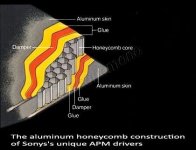"1 cm" of aluminium is meaningless. You must mean 1 cubic centimetre.
The density of aluminium is 2.7 g/cm^3
What is the density of fibreglass?
The density of aluminium is 2.7 g/cm^3
What is the density of fibreglass?
Forgive me for not welcoming you to the forum, weiberheld. 😳
The density of the most common form of fibreglass (E-glass) is 2.6 g/cm^3, which is comparable to that of aluminium.
I therefore conclude that the choice of whether to use an aluminium or fibreglass woofer cone is not simply influenced by density.
The density of the most common form of fibreglass (E-glass) is 2.6 g/cm^3, which is comparable to that of aluminium.
I therefore conclude that the choice of whether to use an aluminium or fibreglass woofer cone is not simply influenced by density.
FWIW aluminum IS used for speaker cones, and maybe somebody made one out of fiberglass, the point being that both must be very thin, a few tenths of a mm at most, or they become impossibly heavy.
Very popular Hartke aluminum cone Bass guitar speakers:

Very popular Hartke aluminum cone Bass guitar speakers:

Both are used. Fiberglass cone on some subwoofers ( Focal, Dayton,...) and Aluminium was/is used.
For Alu if smart designers you don't need them to weight a lot:
I own a loudspeaker with same kind of drivers in 15" , 4,5" and 1" from same manufacturer. Sound very neutral for the period ( 80's/90's), relatively high sensitivity too ( around 92db spl)..
For Alu if smart designers you don't need them to weight a lot:
I own a loudspeaker with same kind of drivers in 15" , 4,5" and 1" from same manufacturer. Sound very neutral for the period ( 80's/90's), relatively high sensitivity too ( around 92db spl)..
Last edited:
For balance, here's an example of a dual voice coil woofer with a glass fibre (GF) cone:
https://www.visaton.de/en/products/drivers/woofers/gf-200-2-x-4-ohm
https://www.visaton.de/en/products/drivers/woofers/gf-200-2-x-4-ohm
Attachments
There are so many different compromises that need to be made in any driver, cone material is important, but i tend to ignore it and just look at the woofer’s performance.
dave
dave
For a full range driver, I'd go for a woven glass fiber ( or paper ) cone, for a sub, aluminum ( or paper ) cone, I can't see a sub suffering from brake up, but then someone might prove me wrong.
18" aluminum cone woofers are around .5-.6mm thick, some aluminum passive radiators around 1mm, though weight is an advantage with them.FWIW aluminum IS used for speaker cones, and maybe somebody made one out of fiberglass, the point being that both must be very thin, a few tenths of a mm at most, or they become impossibly heavy.

E-Glass is about as stiff as aluminum, but Aramid (aromatic polyamide) and carbon fiber have higher stiffness to weight, so are usually preferable when using relatively exotic materials.
Art
Many thanks first! 🙂 also of course to everyone else who commented.18" aluminum cone woofers are around .5-.6mm thick, some aluminum passive radiators around 1mm, though weight is an advantage with them.
View attachment 1053941
E-Glass is about as stiff as aluminum, but Aramid (aromatic polyamide) and carbon fiber have higher stiffness to weight, so are usually preferable when using relatively exotic materials.
Art
Now if I wanted to make a 12 inch sandwich woofer with two layers of aluminum and one layer (kevlar or whatever works). What would you say, how thick should the individual layers be?
From what I've seen glass/kevlar cones tend to get their first frequency kink or breakup peaks lower in frequency than aluminum or paper. This often has a benign or even musical sound, tending to emphasize melody fundamentals, but if you manage to get the treble and mids balanced it becomes evident as a problem and is more difficult to correct. In this sense paper or poly cones are nice in that you can apply damping compound to the surround to correct the problem, but it is difficult or impossible to adequately damp a heavier cone material like glass or aluminum.
The GF-200 woofer shows this problem quite clearly at 900Hz if you overlook the vast vertical scale (THANKS Visaton, no really, thanks for deceiving us with squashed driver charts, I'm SURE we couldn't spend our money better elsewhere):

The GF-200 woofer shows this problem quite clearly at 900Hz if you overlook the vast vertical scale (THANKS Visaton, no really, thanks for deceiving us with squashed driver charts, I'm SURE we couldn't spend our money better elsewhere):
Hey! Why do you complain? It sure LOOKS flat to me!!!!
Oh, you mean those funny numbers on the left?
WHO reads them anyway? 😉 😉
Oh, you mean those funny numbers on the left?
WHO reads them anyway? 😉 😉
Somewhere between the thickness of the cone material described in post #6 or #10, thickness depending on the excursion you want the cone to produce without deformation.Now if I wanted to make a 12 inch sandwich woofer with two layers of aluminum and one layer (kevlar or whatever works). What would you say, how thick should the individual layers be?
- Home
- Loudspeakers
- Subwoofers
- Aluminum or Fiberglass Woofer cone ? And what is the weight of 1cm Aluminium ?


